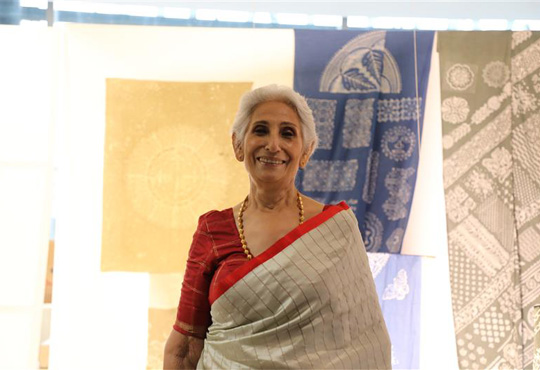How Transdisciplinary Education Shapes the Future of Learning

Professor Usha Nehru Patel, Director Academic, Indian Institute of Art and Design (IIAD) in an interaction with Higher Education Review shared her views on how transdisciplinary education differs from multidisciplinary and interdisciplinary approaches, how it redefines traditional boundaries between academic disciplines, how curriculum designers can integrate transdisciplinary approaches into existing systems and more.
How does transdisciplinary education differ from multidisciplinary and interdisciplinary approaches?
Transdisciplinary education goes beyond just linking different subjects. It brings these subjects together to focus on one common question or a real-world problem. In a multidisciplinary approach, subjects are taught separately but concurrently. In an interdisciplinary approach, subjects overlap and share ideas. But with transdisciplinary education, the borders between subjects disappear completely. The problem or question determines which knowledge or subjects are applied, rather than the subjects dictating everything. This approach shifts teaching from a focus on individual subjects to a method that teaches how to think by combining knowledge from multiple subjects.
How does transdisciplinary education redefine traditional boundaries between academic disciplines?
Transdisciplinary education in design breaks traditional academic boundaries by integrating knowledge and methods from multiple disciplines into a unified approach. It moves beyond simply combining fields to create new ways of thinking and solving complex, real-world problems holistically. This approach promotes collaboration, systemic thinking, and innovation, preparing students to address societal challenges with flexible, sustainable solutions across diverse domains. Instead of isolated specialties, it nurtures designers as facilitators of interconnected knowledge ecosystems for impactful, future-ready design.?
How can curriculum designers integrate transdisciplinary approaches into existing systems?
Integrating transdisciplinary approaches into design curricula means blending multiple disciplines into a unified learning experience focused on solving complex, real-world problems. It emphasizes collaboration, systems thinking, and sustainability while breaking down traditional subject boundaries.
Key elements include project-based learning with real challenges, teamwork across diverse fields, shared design methods, and reflective practices. This prepares designers to think critically and creatively, addressing societal and environmental issues holistically and innovatively. The approach fosters adaptable designers capable of navigating dynamic, interdisciplinary environments effectively.
IIAD’s curriculum equips students to think beyond disciplines and respond to real-world, industry-ready contexts with creativity and purpose. Special two weeks within the academic year are dedicated to a transdisciplinary experience at each level.
What teaching strategies foster transdisciplinary thinking among students? How should assessment evolve accordingly?
Learning must become experiential and collaborative. At IIAD, transdisciplinary thinking grows most naturally through experience within the studios. When students work on live projects, community engagements, or studio collaborations, they begin to see how different kinds of knowledge connect. The faculty also plays a facilitative role - encouraging inquiry, dialogue, and reflection. Assessment, in turn, looks at the learning journey process as much as the outcome. We value process, collaboration, and creativity alongside subject mastery. Tools like reflection journals, peer feedback, and open critiques help students understand not just what they designed, but how they arrived there.
How can technology and digital platforms support transdisciplinary learning? How have global challenges influenced the need for this?
Technology allows us to connect disciplines seamlessly - from data visualization and prototyping tools to virtual collaboration spaces. More importantly, global challenges like climate change and AI ethics demand collective problem-solving and team building, as no single discipline can solve them in isolation. Transdisciplinary learning fosters collaboration, empathy, adaptability, and systems thinking skills - skills that technology alone can’t teach, but can certainly support in a significant way.
Why has the knowledge explosion and specialization in academia made transdisciplinary learning essential?
Knowledge today grows faster than any one discipline can contain. Specialization is valuable, but when it becomes isolated, learning loses context. Transdisciplinary education doesn’t discard depth; it ensures that depth connects meaningfully with other multiple perspectives. It helps students understand how their expertise interacts with others’, and that’s where innovation often happens, at the intersections.
What unique skills do students gain through transdisciplinary education, and how does it prepare them for real-world problems?
Students learn to think systemically, communicate across disciplines, and collaborate with diverse teams. They also become comfortable with ambiguity, which is vital for innovation. When students learn to define a problem before solving it, they develop empathy, critical thinking, and creative confidence. These qualities make them not just good designers but effective changemakers.
What role does collaboration play in transdisciplinary education? Can integrating many disciplines risk losing depth?
Collaboration is the heartbeat of transdisciplinary learning. It’s how students learn to negotiate meaning, share ownership, and appreciate perspectives beyond their own. The risk of losing depth is real but it’s managed when students first gain a solid grounding in their discipline before moving outward. The goal is not only to know their areas of specialization, but also to apply the knowledge to a multi-dimensional format by learning from each other and from different specializations.
Could transdisciplinary education reshape accreditation or degree structures in the future?
Absolutely! Education’s future is evolving into a landscape defined by modularity and lifelong learning. We are likely to witness the rise of hybrid degrees, micro-credentials, and adaptable pathways that empower learners to craft personalized educational journeys. Transdisciplinary approaches will transform accreditation by moving away from fixed syllabi toward the assessment of real-world competencies and integrative skills. The fundamental question will no longer be “What did you study?” but rather “How effectively can you synthesize knowledge across fields and apply it in complex, practical contexts?”
Moreover, this shift will encourage institutions to collaborate beyond traditional academic boundaries, fostering partnerships with industries, communities, and international bodies to ensure education is relevant and responsive. Accreditation frameworks will need to become more dynamic, accommodating varied learning experiences such as internships, project-based work, and cross-sector innovations. This will also drive the development of new assessment tools that evaluate critical thinking, creativity, ethical reasoning, and adaptability - skills essential for the challenges of the 21st century.
Additionally, degree structures may become more fluid, with stackable credentials allowing learners to build qualifications incrementally over time. This flexibility supports diverse career trajectories and continuous skill updates, essential in rapidly changing job markets. Ultimately, transdisciplinary education promises to democratize learning by enabling access to intersectional, interconnected knowledge that directly addresses real-world problems, thereby making accreditation and degrees more meaningful reflections of a learner’s full potential and impact.
About the Author
With over 30 years of experience, Professor Usha Patel has been a driving force in advancing art and design education. She has led the prestigious Delhi Metro Uniform Design project and curated an exhibition on Oceanography at the India International Centre. Her publications, including 'Extending the Frontiers of Visual Learning' and 'Designing an Educational Experience of Relevance to Real World Situations,' highlight her expertise in the field.

